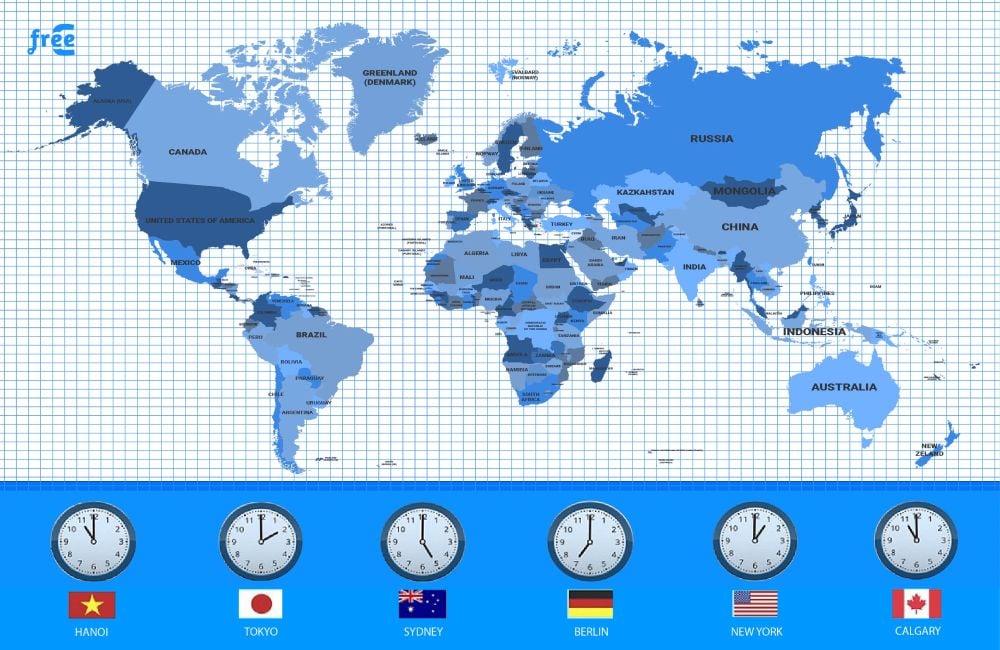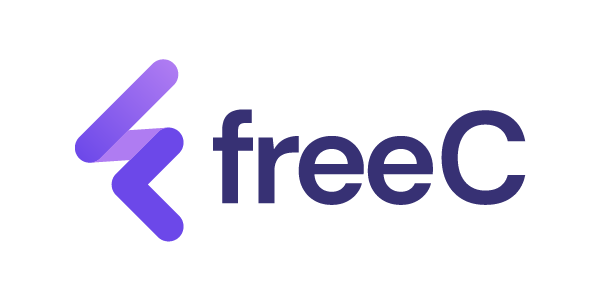In today’s interconnected world, businesses are continually seeking innovative ways to boost productivity and maintain a competitive edge. One often overlooked yet highly impactful strategy is harnessing the power of time zone differences within a global workforce. In this article, freeC will delve into what Time Zone Advantage is, why it’s beneficial, particularly by hiring remote IT workers from Vietnam, can be a catalyst for increased productivity, revolutionize the way your business operates, communicates and thrives.
The Global Nature of Remote Work
The way we work has undergone a remarkable transformation in recent years, and it’s safe to say that remote work has transcended its status as a workplace trend to become a global phenomenon.This transformation has been accelerated by various factors, including technological advancements, changing work preferences and the insights gained from the COVID-19. Consequently, enterprises have expanded their horizons to operate on a global scale, harnessing talent from various corners of the world.
Remote working has experienced a significant surge, witnessing a remarkable 400% increase, while an impressive 73% of businesses plan to adopt remote work in the coming years. As COVID-19 restrictions ease in the local region, the EY 2021 Work Reimagined Employee Survey indicates that just 15% of respondents in Southeast Asia (SEA) express a preference for full-time office work. The survey emphasizes the inclinations of SEA employees, with 32% seeking the freedom to work from various locations, 29% favoring complete remote work, and 23% opting for a hybrid work model that blends office and remote work.
Estimates indicate that there are currently over 10 million remote workers in Southeast Asia, and this number is anticipated to surpass 20 million by 2025. Among the top countries in Southeast Asia for remote work are:
- Thailand
- Indonesia
- Vietnam
- Philippines
- Malaysia
While this expansion unlocks access to a vast reservoir of skilled professionals, it simultaneously poses a formidable challenge: the effective management of operations spanning multiple time zones. At the heart of this transformation lies the need for collaboration across different time zones. For businesses operating across borders, these variations can present both challenges and opportunities.
Vietnamese Time Zone Alignment

Nestled in Southeast Asia, Vietnam boasts a unique time zone alignment that positions it ideally to enhance global productivity. Being in the Indochina Time Zone (ICT, UTC+7), Vietnam shares overlap with both European and North American working hours. This alignment opens up a world of possibilities for businesses looking to extend their operational hours. Due to Vietnam’s time proximity to various time zones, one of the advantages of a remote workforce from Vietnam is the flexibility in working hours, effectively accommodating time-related factors.
Benefits of Working across Time Zone Differences
Consider the example below that illustrates how businesses in the IT have taken advantage of time zones to enhance collaboration and provide round-the-clock service.
GitLab’s Asynchronous Collaboration: GitLab, a web-based platform for software development, has adopted an asynchronous work model that makes efficient use of time zone differences. They have team members spread across over 65 countries. GitLab encourages asynchronous communication and collaboration, meaning that team members work on tasks and communicate without the need for real-time interactions. This allows team members to contribute to projects regardless of their location and time zone. Issues and tasks are documented, and discussions happen over time, ensuring that work continues even when team members are not online simultaneously.
Recruiting IT professionals from Vietnam for remote work offers significant advantages to businesses in various ways. Businesses can derive significant advantages when they adopt effective approaches to outsourcing tasks across different time zones. In fact, remote workers said they were as productive or more productive working remotely, compared to when they were in the office full-time. Without the noise and distractions of an office environment, workers are able to structure their work day to their strengths. Remote workers also save time and money by not needing to commute and have an overall better work-life balance. Let’s explore a couple of its benefits.

Extended Working Hours and Productivity
Time Zone Differences may initially seem like obstacles in Remote Work, but organizations are increasingly leveraging this disparity to establish a 24-hour development cycle. Businesses that leverage this advantage often find that their teams can work together more seamlessly, resulting in better coordination, faster decision-making, and improved project outcomes. This eliminates the need for asynchronous communication, reducing delays in decision-making and project progress. With team members spread across different time zones, work can continue around the clock. As one part of the team completes their workday, another part can take over, ensuring that tasks are being worked on even during non-traditional working hours. This can lead to faster project turnaround times and quicker issue resolution, as there is always someone available to address critical matters. Besides, by strategically assigning tasks to team members in different time zones, you can optimize the workflow.
One of the most compelling reasons to consider outsourcing to Vietnam is the strategic time zone advantage it offers. Unlike dealing with significant time differences that often lead to communication gaps and project slowdowns, Vietnam’s time zone aligns harmoniously with various global markets. Vietnam’s time zone, which falls within Indochina Time (ICT, UTC+7), presents a strategic advantage for organizations with major business hubs in North America and Europe. For instance, Vietnam is typically 6 hours ahead of London, allowing for extended working hours. In comparison to European time zones, Vietnam is 5 to 7 hours ahead, creating an overlap that fosters real-time collaboration. To illustrate the advantage clearly, consider a scenario where a software development project spans multiple countries. With Vietnamese IT professionals on the team, there is potential for round-the-clock productivity. While one team in North America wraps up its workday, the team in Vietnam can seamlessly continue progress, reducing project timelines and accelerating time-to-market – all of which contribute to smoother workflows, increased productivity and provide your business with a competitive edge.
Vietnam is located in the Asian region, so the working hours of IT employees in Vietnam are often consistent with the needs of working in countries in the region such as Korea, Singapore,… Because of the time zone. relatively close, this means that remote IT employees from Vietnam can work during the same hours as companies in both countries without having to deal with large time zone differences. This facilitates simultaneous working and daily communication.
Global Market Expansion
In addition to its thriving talent pool and the advantageous alignment of time zones, Vietnam’s geographical location assumes a pivotal role in broadening the global reach of your business. Positioned at the intersection of major markets, Vietnam serves as a conduit, seamlessly connecting your enterprise to diverse regions across the globe. This strategic geographical positioning not only facilitates efficient communication but also empowers your capacity to serve clients and customers spanning various time zones. When your business leverages Vietnamese resources, it establishes a solid foothold in international markets that may have previously presented significant challenges to access. This, in turn, translates into heightened accessibility, elevated standards of customer service, and enhanced market penetration. Collectively, these factors contribute significantly to bolstering productivity and fostering business growth.
Diverse Perspectives
In an ever-changing and dynamic business environment, embracing a variety of viewpoints becomes imperative for fostering innovation and facilitating growth. When you choose to collaborate with IT Vietnamese professionals, you are opening the door to a melting pot of ideas, talents, and perspectives. With its diverse cultural landscape and highly adaptable workforce, Vietnam offers a rich resource for your team benefits from a wide range of creative approaches.
Embracing this array of diverse perspectives not only serves to enhance productivity but also furnishes your enterprise with the indispensable tools requisite for navigating challenges, seizing opportunities, and maintaining a competitive edge on the global stage. The amalgamation of various cultural backgrounds and work methodologies catalyzes an environment where creativity thrives and novel solutions to intricate problems are nurtured. Ultimately, the strategic incorporation of diverse perspectives from Vietnam’s IT talent pool becomes a pivotal asset, fortifying your organization’s position in the ever-expanding global marketplace.
Challenges of Working across Time Zone Differences
It’s important to acknowledge that managing remote teams across time zones is not without its challenges. As teams expand across diverse geographical locations, the coordination of tasks, the facilitation of continuous and effective communication, and the equitable distribution of workloads can become increasingly intricate. In this section, we will explore the key challenges frequently encountered in the context of operating within a globalized work environment, shedding light on the obstacles that need to be addressed to foster successful cross-time zone collaboration.

Communication Challenges
Working across different time zones introduces heightened communication complexities due to the inherent asynchronicity of interactions. Although asynchronous communication offers the advantage of flexibility, it can give rise to misunderstandings stemming from the absence of immediate clarifications, consequently increasing the likelihood of errors in task execution. Furthermore, the absence of real-time engagement may impede impromptu brainstorming sessions and the development of camaraderie among team members, thereby affecting the cohesive sense of unity typically associated with synchronous collaboration.
Navigating these challenges necessitates a proactive approach to communication that includes clear and comprehensive documentation, detailed task assignments, and structured communication protocols. Employing advanced collaboration tools that facilitate asynchronous discussions and file sharing can further mitigate these issues. By embracing these strategies, organizations can harness the advantages of a globally dispersed workforce while effectively addressing the communication hurdles posed by varying time zones.
Coordination and Workflow Disruptions
The effective management of time zone disparities presents significant hurdles, with coordination and workflow interruptions. In a globalized working landscape, the imperative for expeditious input and approvals from colleagues scattered across diverse time zones has the potential to generate bottlenecks and unwelcome delays in the progression of project schedules. The task handover process between teams situated in disparate time zones necessitates a meticulous approach to guarantee a harmonious transition and to forestall any interruptions in the continuity of work processes.
To compound these challenges, unforeseen variables such as public holidays and alterations in daylight saving time can further exacerbate the intricacies of scheduling and coordination efforts. To mitigate these disruptions and maintain the seamless flow of work, the implementation of effective project management tools and the establishment of clear communication protocols are of paramount importance. These resources serve as the linchpin in the endeavor to minimize the impact of time zone disparities and, consequently, to sustain the unfettered progression of work activities.
Work-Life Balance and Burnout
Balancing work responsibilities and personal well-being becomes notably intricate when navigating time zone disparities. Collaborators may encounter the necessity of adapting their daily routines to accommodate meetings scheduled at unconventional hours, thereby disrupting their customary schedules. The expectation to remain accessible during non-standard work periods can erode the boundaries separating professional duties from personal life, heightening the vulnerability to burnout stemming from prolonged working hours. Furthermore, the absence of overlap in work hours can impede individuals from disconnecting from their professional obligations and achieving full rejuvenation, thereby precipitating diminished productivity and a reduced sense of job satisfaction.
However, these challenges can be mitigated through effective communication strategies, flexible scheduling, and a focus on employee well-being.
Future-Proofing Remote Work Strategies
Establishing Precise Guidelines
Establishing precise guidelines is essential for upholding efficient communication in the face of time zone disparities. The clear delineation of expected response times, designated availability windows, and preferred communication channels serves to provide team members with a comprehensive understanding of when to anticipate updates and when their colleagues may be offline. This level of transparency cultivates a culture characterized by empathy and tolerance, thereby mitigating the frustration that may arise due to delayed responses.
Furthermore, the articulation of anticipations concerning the transfer of responsibilities and project progress reports ensures the seamless continuity of work, even when team members are geographically dispersed across different time zones. Ultimately, well-defined expectations construct a systematic framework that facilitates streamlined collaboration and diminishes the potential for misunderstandings in a globally distributed work environment.
“Follow the Sun” model
The “Follow the Sun” model empowers organizations to harness the capabilities of global teams located in different time zones, thereby facilitating uninterrupted, round-the-clock productivity, smooth workflow transitions, and continuous customer support. By capitalizing on the potential of global collaboration, this model unites diverse skill sets and perspectives, enabling businesses to explore new markets, foster innovation, and tackle complex challenges.

The “Follow the Sun” model is a strategic approach adopted by companies to provide 24/7 customer support across a spectrum of time zones. A parallel technique known as “hands-on and shake-off sessions” aligns with the “Follow the Sun” model in the context of outsourcing. This process involves the seamless transition of tasks from one team to another, typically occurring an hour before the concluding hours of the former team’s workday. During this overlapping hour, the outgoing team transfers their ongoing tasks, facilitating a smooth continuum of work. This cycle repeats as tasks move across teams situated in varying time zones.
For instance, consider a scenario involving a software development company with teams situated in Asia, Europe, and North America. When the Asian team concludes their workday, the European team seamlessly takes up the baton, followed by the North American team, resulting in the achievement of continuous 24-hour productivity.
Utilize Communication and Management Tools Effectively
When dealing with Time Zone Differences, it becomes imperative for teams to leverage convenient cloud-based platforms designed for streamlined communication and collaboration. There are several noteworthy options in the realm of virtual whiteboards, exemplified by the likes of Jamboard and Microsoft Whiteboard, which offer robust tools for fostering effective teamwork. Furthermore, the establishment of an online document repository, such as Google Drive or Atlassian Confluence, is of paramount importance to facilitate seamless information sharing and documentation.
Leading technology conglomerates and a multitude of innovative startups have responded to the challenge of time zone disparities by providing online calendar solutions that empower teams to schedule virtual meetings with a keen awareness of these variations. Prominent examples include Microsoft Outlook, Google Calendar, and Zoho, each equipped with features that enhance the coordination of cross-time zone interactions.
The judicious utilization of these communication and management tools serves to simplify the process of identifying mutually convenient time slots when all team members are available. Embedding time zone information and individual availability within user profiles further streamlines coordination efforts, promoting effective collaboration in the face of geographical and temporal disparities.
Be Attentive to Holidays
While it may seem self-evident, organizations that operate with teams spanning multiple time zones should establish and maintain a publicly accessible calendar of local holidays for each relevant country. The act of recognizing and showing respect for these diverse public holidays in various regions serves as a vital measure to mitigate miscommunication and mitigate potential disruptions in task execution arising from unforeseen work stoppages. By proactively acknowledging and accounting for holidays across different time zones, teams can adeptly adjust their schedules and project timelines, thereby ensuring the smooth and uninterrupted progression of work.
This practice not only demonstrates cultural sensitivity but also enables more effective planning. It affords the opportunity to redistribute workloads and coordinate tasks in a manner that accommodates holiday periods. Ultimately, staying informed about local holidays plays a pivotal role in fostering a harmonious global work environment and bolstering seamless collaboration. Often underestimated, this aspect can unexpectedly pose significant challenges.
In an era where remote work is the norm, businesses must adapt to the challenges and opportunities presented by a globally dispersed workforce. Hiring Vietnamese IT talent for remote positions is a strategic move that aligns time zones, extends working hours, enhances productivity, and ultimately strengthens an organization’s position in the global market. By recognizing and harnessing the time zone advantage, businesses can unlock their full global potential and ensure seamless operations across borders.
GET IN TOUCH WITH FREEC CONSULTING









